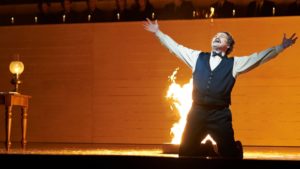Louis Riel: An Impressive Revival

Louis Riel, Canada’s leading opera composed by Harry Somers with the libretto written by Mavor Moore and Jacques Languirand, first produced in 1967 to commemorate the centennial has been revived for the country’s 150th anniversary of confederation. The 2017 production is a collaboration between the Canadian Opera Company in Toronto and the National Arts Centre in Ottawa.
Politically, this updated work, while the music and much of the libretto remain the same, is greatly changed. Fifty years ago Riel was widely regarded as a traitor by the Anglophone population of Canada. Director Peter Hinton who regards the original production “as an artefact of its time” tells the story from another point of view through his staging, casting, and use of language. Although the original artists used English, French, and Cree, in Hinton’s version Michif, the language of the Métis people has been added. Included in the cast are indigenous community members. Indigenous dances are choreographed by Santee Smith, an Onkwehon:we. Unfortunately, the surtitles in small print using the multiple languages were difficult to read, particularly since they went by so quickly.
The minimal sets combined with exploitation of the width of the large stage give the audience a sense of the enormous prairie with its then small population. It also emphasizes Riel’s loneliness as his world is crushed. At given moments the upstage scrim rises to reveal a high wall. Behind it are two rows of seats in which men, dressed in business suits, watch as if witnessing a trial, although they often express anger. During the courtroom scenes, the judge observes from the first row. These performers who are all chorus members are dressed in contemporary style. They are looking back at their history, much as the audience is.
Ottawa, represented by a backdrop that resembles an architectural drawing, would seem to symbolize Sir John MacDonald’s dream for the country.
The production’s color scheme depends heavily on black and red. At the opening, a large group of Métis enter clothed in red. They later reappear garbed in black. Sir John MacDonald (James Westman) wears a red and black plaid suit, which adds a comic note to his character. In the first scenes, Riel is seen in a black vest and pants with a white shirt and black tie, while his mother and sister wear black dresses with white collars.
Bonnie Beecher’s effective lighting is dominated by red as well, which makes sense in a work dominated by rebellion, violence, and a battle that takes place at Red River.
Harry Somers’ mid-twentieth century modernist music is still a pleasure to the ear. Strangely, the first act has comparatively little singing. The second act is stronger both dramatically and musically. Act three, the most thrilling, presents the soon-to-be hanged Louis Riel as a believer in human rights.
Baritone Russel Braun is excellent in the complex role of Louis Riel both as a singer and actor. Simone Osborne, who plays Marguerite, Louis Riel’s wife, has a show stopping moment in her third act aria, “Song of Skateen.” The enormous cast of almost a hundred people is a deeply involved ensemble. Director Peter Hinton is to be congratulated.
Composer ………………………………… Harry Somers
Director …………………………………… Peter Hinton
Libretto……………………………………. .Mavor Moore and Jacques Languirand
Conductor …………………………………. Alexander Shelley
Set Designer ……………………………….. Michael Gianfresco
Costume Designer …………………………. Gillian Gallow
Lighting Designer ………………………….. Bonnie Beecher